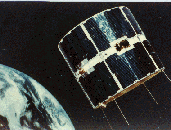|
The COS-B Satellite
The ESA mission COS-B, along with NASA’s SAS-2,
provided the first detailed views of the Universe in Gamma-rays. COS-B carried a single
large experiment, the Gamma-Ray Telescope, which was responsibility of a
group of European research laboratories know as the
Caravane Collaboration. Launched on the 9 August 1975, COS-B was
originally projected to last two years, but it operated successfully for 6
years and 8 months. It provided the first complete map of the Galaxy in
gamma-rays.
Mission Characteristics
Page authors: Lorella Angelini Jesse Allen HEASARC Home | Observatories | Archive | Calibration | Software | Tools | Students/Teachers/Public Last modified: Thursday, 24-Sep-2020 18:30:39 EDT |


